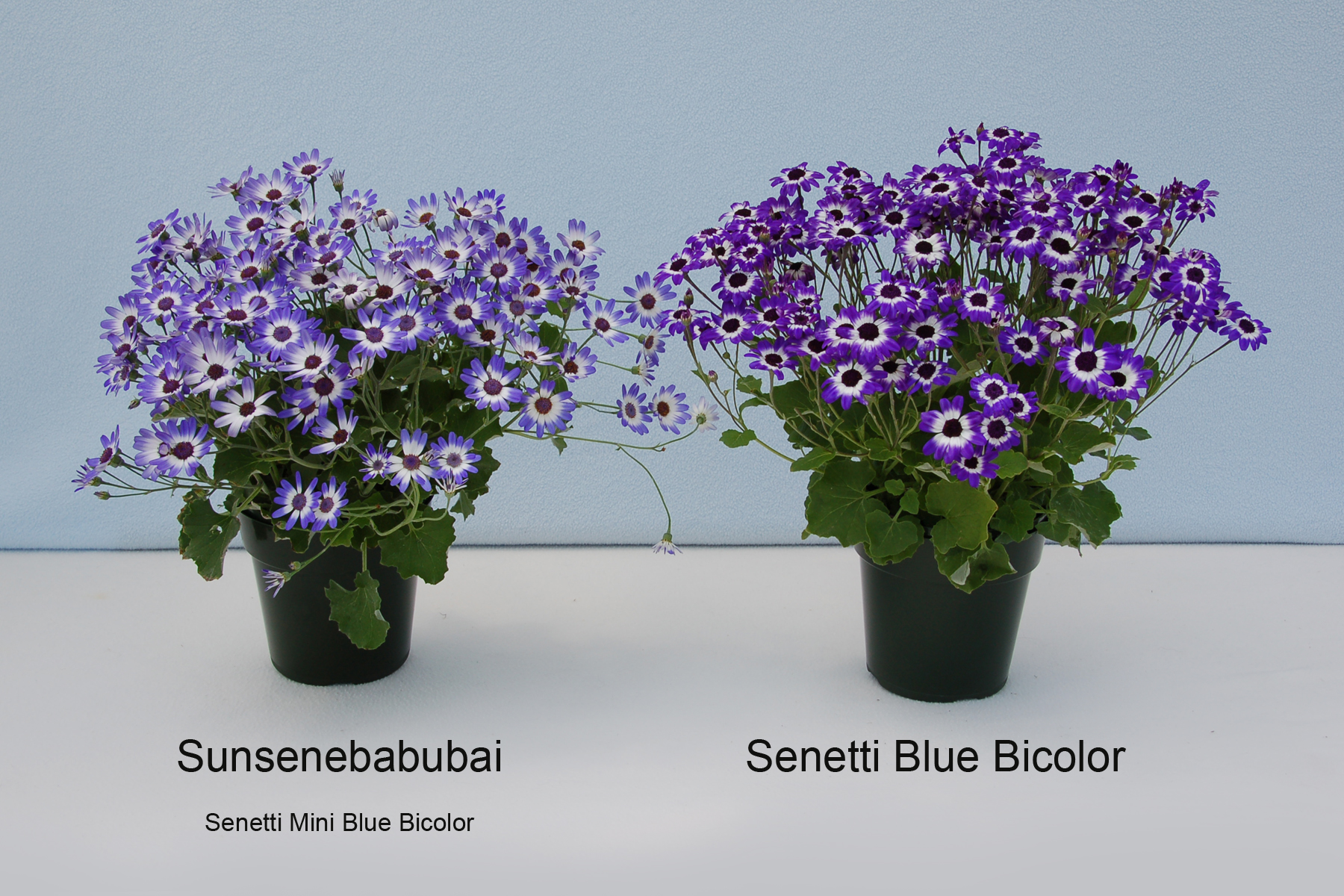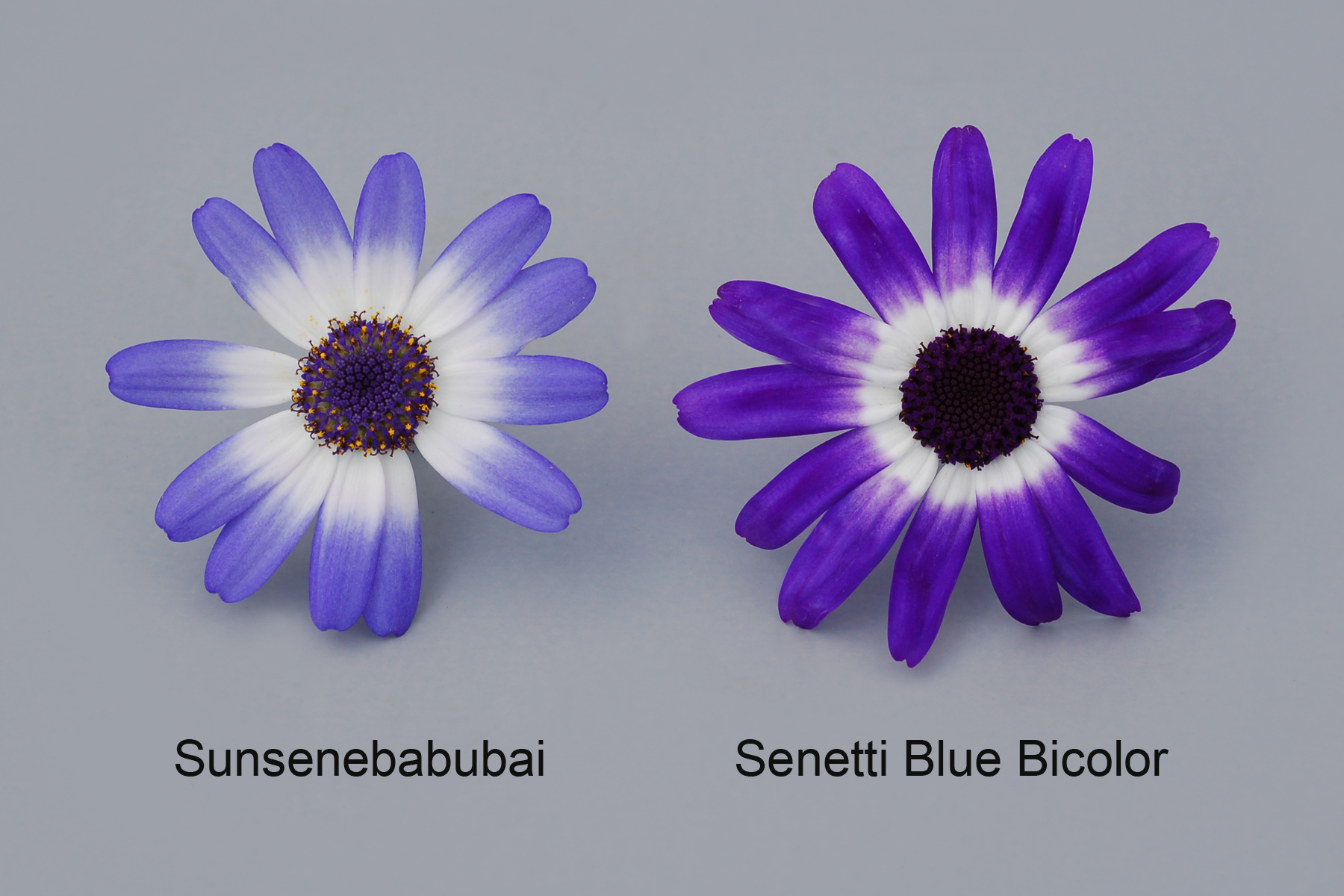Sunsenebabubai
| Denomination: | 'Sunsenebabubai' |
|---|---|
| Trade name: | Senetti Mini Blue Bicolor |
| Botanical Name: | Pericallis cruentus x P. lanata |
| Applicant/Holder: |
Suntory Flowers Limited Administrative Division 4-17-5 Shiba, Minato-ku Tokyo 108-0014 Japan |
| Breeder: |
Kiyoshi Miyazaki, Shiga, Japan |
| Agent in Canada: |
BioFlora Inc. 38723 Fingal Line R.R. #1 St. Thomas, Ontario N5P 3S5 Canada Tel: 519-317-7511 |
| Application Date: | 2007-04-20 |
| Application Number: | 07-5895 |
| Grant of Rights Date: | 2009-08-25 |
| Certificate Number: | 3566 |
| Date rights surrendered: | 2014-07-31 |
Variety Description
Variety used for comparison: 'Senetti Blue Bicolor'
Summary: 'Sunsenebabubai' has longer petioles and stronger degree of indentation of the leaf blade margin than 'Senetti Blue Bicolor'. The main colour on the upper side of the ray floret of a newly opened flower of 'Sunsenebabubai' is violet blue and fading as it ages whereas it is blue violet for 'Senetti Blue Bicolor'.
Description:
PLANT: upright bushy growth habit, medium degree of branching
STEM: light green, medium anthocyanin colouration, dense pubescence, medium to thick, smooth
LEAF: alternate arrangement along stem, simple type
LEAF BLADE: cordate shape, obtuse apex, cordate base, dentate margin, medium degree of lobing, strong degree of undulation of margin, strong degree of indentation of margin, sparse to moderate pubescence on upper side, medium green on upper side, pattern of venation is palmate
PETIOLE: medium to strong anthocyanin colouration at base
INFLORESCENCE: head type
FLOWER: medium number of ray florets
RAY FLORET: short, narrow to medium width, reflexing along longitudinal axis of majority, flat in cross-section, elliptic shape, obtuse apex, two colours on upper side, main colour on upper side is violet blue fading to lighter violet blue when aged, secondary colour on upper side is white, main colour on lower side is violet blue (RHS 92C) fading to white (whiter than RHS 155C) towards base
DISC: present
Origin & Breeding History: 'Sunsenebabubai' originated from a cross made in January 1997 between the female parent, a breeding line designated '7S-68c', and the male parent, a seedling of Senecio heritieri. The cross was conducted in Hokuto-shi, Yamanashi, Japan. The resultant seedlings were grown in pots in a glasshouse and evaluated. In October 1998, 'Sunsenebabubai' was selected based on its plant growth habit, flower size and flower colour. It was later propagated by cuttings and grown in pots in Hokuto-shi, Yamanashi, Japan where it was subjected to trials starting in July 2000.
Tests & Trials: Trials for 'Sunsenebabubai' were conducted in a polyhouse during the winter and spring of 2008 at BioFlora Inc. in St. Thomas, Ontario. The trial included 15 plants per variety. The plants were grown from rooted cuttings which were transplanted into 15 cm pots on March 19, 2008. The plants were provided a natural cold treatment for approximately 5 weeks at 10°C until flower buds were visible and then grown further at 18°C. Measured characteristics were based on measurements taken from 10 plants or parts of plants on May 27, 2008. All colour determinations were made using the 2001 Royal Horticulture Society (RHS) Colour Chart.
Comparison tables for 'Sunsenebabubai' with reference variety 'Senetti Blue Bicolor'
Petiole length (cm)
| 'Sunsenebabubai' | 'Senetti Blue Bicolor' | |
|---|---|---|
| mean | 6.0 | 3.8 |
| std. deviation | 1.34 | 0.49 |
Colour of ray floret (RHS)
| 'Sunsenebabubai' | 'Senetti Blue Bicolor' | |
|---|---|---|
| upper side - main colour | darker than 95B fading to 95C | N88A-N89C |
Click on image for larger view

Cineraria: 'Sunsenebabubai' (left) with reference variety 'Senetti Blue Bicolor' (right)
Click on image for larger view

Cineraria: 'Sunsenebabubai' (left) with reference variety 'Senetti Blue Bicolor' (right)
- Date modified: